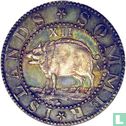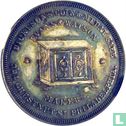

Enlarge image
Sommer Islands (Bermuda & Philadelphia) "Hogge" shilling 1616


Catalogue information
LastDodo number
6477113
Area
Tokens / Medals
Title
Sommer Islands (Bermuda & Philadelphia) "Hogge" shilling 1616
Publisher
Value
Country
Year
1616
Collection / set
Material
Weight
Variety / overstrike
Obverse
SOMMER * ISLANDS * XII (pence)
Reverse
Dickeson's Coin & Medal Safe * Evan's & Watson * Makers. 304 Chestnut St Philadelphia.
Privy mark
Mint mark
Designer
Engraver
Dimensions / Diameter
33
Number
Details
The earliest coins struck for British North America were the Sommer Islands' (sometimes spelled Somer Islands or Isles) 2, 3, 6, & 12 pence.
In 1609, nine ships carrying colonists to the new colony of Jamestown in Virginia shipwrecked there during a severe storm, stranding the passengers on an island. The passengers, however, were greeted by an abundance of wild hogs, believed to have descended from a group left by Juan Bermudez, a Spanish explorer who discovered the islands more than 100 years earlier.
In 1610, the islands were named “Sommer Islands” after the death of Sir George Somers, one of the passengers who had been stranded.
On June 29, 1615, the Bermuda Company was established to colonize these islands. The company’s authorization included the right to strike coins and soon brass pence, were minted. The wild hog that inhabited the islands was used as the obverse design and many collectors refer to these coins as “hogge money.” Tthe reverse usually depicted a ship.
Most other American colonies were run in accordance with English charters that did not permit the colonial governments to manufacture coins.
The first English colony to challenge this prohibition was Massachusetts Bay. In 1652 the colony of Massachusetts Bay established a mint in Boston.
The Massachusetts Bay Colony's mint at Boston was run by John Hull, who was assisted by Robert Saunderson. Its output consisted mostly of silver shillings, coins valued at twelve pence. The Massachusetts Mint also produced smaller silver coins valued at six pence, three pence and two pence. Except for the twopence pieces, which were dated 1662, all of the coins minted at Boston carried the date 1652. Although a popular myth holds that the coins were dated 1652 to deceive the monarch into believing that the colony had ceased minting coins after he ascended to the throne, in reality the date almost certainly refers to the year that the Massachusetts Bay General Court authorized their production.
The mint’s first silver shillings bore simply the letters NE (for New England) on the obverse and the values XII (12 in Roman numerals), VI (6) or III (3) on the reverse. Easily counterfeited or clipped, these coins were quickly replaced by ones featuring a tree on their obverse. Three styles of trees were used over the thirty years of production: a willow (1652-60), an oak (1660-67) and, most familiar of all, a pine (1667-82).
In Maryland, Cecil Calvert contracted with England's Royal Mint to produce silver coins valued respectively at one shilling, six pence and four pence. These carried no date, but they were made around 1659, during the Commonwealth period when England had no king and was ruled by Parliament. The number minted is unknown, and they evidently circulated in the Maryland Colony for just a few years. All are rare and highly sought by collectors today.
Connecticut had an advantage over the other colonies because it possessed copper mines. Outside the town of Granby, Dr. Samuel Higley created his own mint from scratch. He smelted the raw ore himself and made his own dies for the minting of copper three pence coins dated either 1737 or 1739. The principal devices were a stag seen in profile on the obverse and either three hammers or a single axe on the reverse. Higley's coins proved quite successful locally, though by English standards they were underweight. When found today, these very rare coins are almost always well worn, and this proves that they circulated for many years.
In New Jersey, the colonists used coins imported from Ireland during the 1680s. These copper pieces were made a legal tender by the General Assembly in May of 1682. They came in two sizes, the larger ones valued at one-half penny and the smaller coins at a farthing, or one-quarter penny. One side of these coins shows a seated figure of a king playing a harp (symbolic of Ireland), and the other side shows Saint Patrick. These coppers are some of the more available coins from the American colonial period.
Among the rarest and most obscure colonial pieces are the brass and pewter tokens issued by Francis Lovelace, governor of New York from 1668 to 1673. The New Yorke token is undated but is believed to date from this period. Its obverse shows Cupid chasing after Psyche, who wears butterfly wings. The reverse features the Lovelace Family arms, which is dominated by an eagle. Probably intended to pass as farthings, these extremely rare tokens are believed by some to have been made in Bristol, England.
In 1688, Richard Holt received a royal patent to manufacture tokens for use in the American colonies. Made of tin, these tokens were valued at 1/24 real. (The real was a Spanish unit of value, and the coins of Spain's American colonies were then widely used throughout the New World.) The obverse shows England's King Charles II astride his horse, while the reverse displays the armorial shields of England, Scotland, Ireland and Wales linked by a chain. Very little is known of these rare pieces, such as where and for how long they actually circulated.
Another individual who received royal permission to make coins for Ireland and for the American colonies was William Wood. Both issues of his copper coins, which are dated 1722, 1723 and 1724, show a portrait of King George I on their common obverse. The American coins feature an English rose on their reverse, while the Irish pieces display a seated figure of the goddess Hibernia (Latin for Ireland) seated beside a harp. Though officially valued at two pence, one penny and one-half penny, respectively, Wood's coins were very underweight and were largely rejected by the Irish. As a result, the Irish issues were also shipped to America, since the American colonists had too few coins to complain about their quality. Even so, they proved to be just as unpopular here as they had been in Ireland.
Another series of Irish coins that found their way to the American colonies were the Voce Populi coppers, so called because of their obverse legend, which in Latin means “By the voice of the people.” Dated 1760, several varieties of farthings and halfpennies are known. These were created by a Mr. Roche of Dublin. Their obverse features a laureate bust of King George II, while the reverse design is a seated figure of Hibernia with a harp. Exactly where and when these circulated in America is uncertain, but they are highly collectable.
Tokens honoring Sir William Pitt, who defended the American colonists against the unpopular Stamp Act of 1765, were made in both farthing and halfpenny sizes bearing the date 1766. A bust of Sir William appears on the obverse, while the reverse features a merchant ship under full sale, which is identified as AMERICA. The Pitt Tokens are quite collectable and serve as important historic relics.
Of all England's American colonies, Virginia came closest to realizing a useful coinage from the Mother Country, but it simply came too late. In 1773, thousands of copper halfpennies were minted in London for shipment to Virginia. These attractive coins carry the portrait of King George III on their obverse and the royal arms of Great Britain on their reverse. Thanks in large part to the discovery of a hoard of uncirculated specimens, Virginia halfpennies are readily available in Mint State grades. The Virginia halfpennies are among the most common colonial era coins, and they are a perennial favorite with American collectors.



